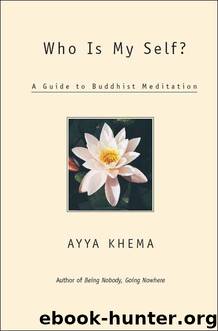Who Is My Self?: A Guide to Buddhist Meditation by Khema

Author:Khema
Language: eng
Format: epub
ISBN: 9781614290315
Publisher: Wisdom Publications
Published: 1997-10-09T05:00:00+00:00
In the fourth jhāna we no longer experience bodily sensations but are only aware of the stillness of our mind, our emotions, and feelings. So in the fifth jhāna, “passing entirely beyond bodily sensations” is not something that has to be done specifically. Rather, it is “all sense of resistance” that must be deliberately dropped. This refers, first and foremost, to the limitation of the body as we normally experience it. We conceptualize a distinct boundary: “Where my skin ends is where my body ends,” and that is where “I” end too, or so we believe. There is a definite resistance, a limit we impose on ourselves. In the first four fine-material absorptions, that boundary has already been enlarged to some extent. At any rate, it is not quite as rigid and restricted as it is in our ordinary everyday life, where we know exactly where we begin and end, or at least imagine we do; we see ourselves as filling a prescribed space.
When we come out of fourth jhāna and want to reach “the infinity of space,” we can notice the boundaries of the body, wherever they may be at the moment, and start stretching its limits further and further. The contemplation on the four elements, referred to earlier, gives some inkling of this process.
The Buddha speaks of “non-attraction to the perception of diversity.” We need to get beyond that attraction to “singleness” of one person, one house, one tree, one forest, one sky, one horizon. We perceive everything as separate, as having a boundary. This attraction to diversity is the natural human state. The Pali word for diversity is papañca, “mani-foldness,” and nature abounds in it. Within every species there are countless “individuals.” Human beings are a case in point: we all look a little different from each other. We are attracted to that diversity. When we are in a forest, we enjoy the shape of each particular tree, the characteristics of each branch or leaf; we find that beautiful. Similarly, we look up at the sky and appreciate the single stars, or the moon. We do the same with people: attracted by one face, finding it pleasing, or turning away from another. We must go beyond all that in order to get into the infinity of space.
There are two methods of doing this, and we can use either or both depending on how difficult we find it to expand the mind sufficiently. One way, as mentioned above, is to go to the boundaries of the body, wherever they are experienced, and begin to expand them until they are totally dissolved in infinity. Should we come to a blockage where expansion seems to go no further, we can then use the perception of forests, meadows, mountains, valleys, rivers, oceans; then further to this whole globe we live on; and even further to the sky that surrounds it and the horizon. When we come to the horizon, we let go of that too, and there is the infinity of space.
Download
This site does not store any files on its server. We only index and link to content provided by other sites. Please contact the content providers to delete copyright contents if any and email us, we'll remove relevant links or contents immediately.
The Way of Zen by Alan W. Watts(6506)
Ego Is the Enemy by Ryan Holiday(5294)
The Art of Happiness by The Dalai Lama(4063)
The Book of Joy by Dalai Lama(3901)
Why Buddhism is True by Robert Wright(3404)
Spark Joy by Marie Kondo(3249)
Shift into Freedom by Loch Kelly(3134)
Happiness by Matthieu Ricard(2992)
A Monk's Guide to a Clean House and Mind by Shoukei Matsumoto(2868)
The Lost Art of Good Conversation by Sakyong Mipham(2578)
The Meaning of the Library by unknow(2505)
The Unfettered Mind: Writings from a Zen Master to a Master Swordsman by Takuan Soho(2249)
The Third Eye by T. Lobsang Rampa(2225)
Anthology by T J(2161)
Red Shambhala by Andrei Znamenski(2151)
The Diamond Cutter by Geshe Michael Roach(2019)
Thoughts Without A Thinker: Psychotherapy from a Buddhist Perspective by Epstein Mark(1961)
Twilight of Idols and Anti-Christ by Friedrich Nietzsche(1850)
Advice Not Given by Mark Epstein(1839)
